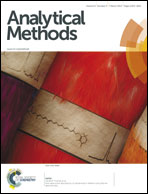A novel method for cetylpyridinium bromide determination in aqueous solution based on fluorescence quenching of dye†
Abstract
A new, highly selective and sensitive fluorescent detection method was developed for determining quaternary pyridinium salts cationic surfactant in an aqueous solution of polyoxyethylene-23-lauryl ether (Brij 35). The method was based on the emission of a fluorescent dye, disodium-4,4′-bis-(4-anilino-6-morpholino-s-triazin-2-ylamino)-2,2′-stilbenedisulfonate (CXT), was quenched by cetylpyridinium bromide (CPB). The fluorescence intensity of CXT showed distinct changes towards CPB with excellent selectivity and sensitivity among a series of common surfactants at the optimum pH 8.0. Furthermore, the fluorescence of the CXT/CPB complex is not affected by other common surfactants and most anions commonly associated with the quaternary pyridinium salt cationic surfactant in environmental samples. Also, the fluorescent intensity of CXT (5.0 μM) shows a linear response toward the concentration of CPB from 0 to 20 μM (R2 = 0.9956) and the detection limit was calculated to be 65 nM. The method is found to be precisely applicable to the analysis of CPB in real environmental samples.


 Please wait while we load your content...
Please wait while we load your content...